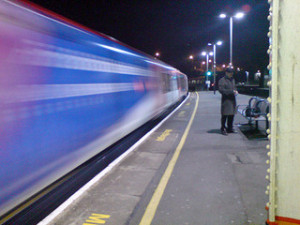 Speeding is a factor in countless accidents every single day, leaving behind serious injuries and grieving families. As we have all been reminded in the past week, the danger of speeding isn’t confined to cars. The thoughts of our entire San Francisco/Oakland train accident law firm go out to the victims of the terrible train derailment in Philadelphia. As with so many accidents, we believe the very best way to honor the victims is by ensuring such tragedies are prevented in the future. Implementing Positive Train Control is one way we can prevent future train tragedies.
Speeding is a factor in countless accidents every single day, leaving behind serious injuries and grieving families. As we have all been reminded in the past week, the danger of speeding isn’t confined to cars. The thoughts of our entire San Francisco/Oakland train accident law firm go out to the victims of the terrible train derailment in Philadelphia. As with so many accidents, we believe the very best way to honor the victims is by ensuring such tragedies are prevented in the future. Implementing Positive Train Control is one way we can prevent future train tragedies.
Speeding and Lack of Safety Controls Eyed in Philadelphia Derailment
According to CNN, eight people died and more than 200 were injured when a Amtrak train derailed just north of Philadelphia last week. The accident occurred on a well-traveled route from Washington to New York, at a curve in the track near Frankford Junction. As the news unfolded, the National Transportation Safety Board (“NTSB”) revealed a disturbing fact – the train was travelling 106 mph as it entered the curve, despite the fact that the curve carries a 50 mph speed limit.
CNN reports that Amtrak personnel spent the weekend after the tragic derailment installing an Automatic Train Control (“ATC”) system, technology that can slow a speeding train, on the track near where the accident occurred. An ATC system was already in place on the curve’s southbound tracks, where a 110 mph speed limit leads into the curve, but was not installed on the northbound rail, where the preceding track carries an 80 mph limit. CNN also noted that Amtrak is in the process of installing Positive Train Control (“PTC”) throughout its rail system, a programmable system ATC whereby transponders in the tracks communicate with train’s computer systems to convey information about speed limits to the conductor. Like ATC, PTC systems will apply the brakes automatically if the engineer does not respond to the notification.
The NTSB’s Call for Automatic Speed Controls on U.S. Rails
Implementing PTC throughout the nation’s rail system is one of the ten items on the NTSB’s “Most Wanted List” for 2015, a yearly list of the agency’s advocacy priorities. According to the agency, PTC can prevent accidents before they happen and “[w]ithout it, everybody on a train is one human error away from an accident.” In the wake of an accident that killed 25 and injured more than 100 train passengers in Chatsworth, California in 2008, Congress passed a mandate requiring major carriers to implement PTC by the close of this year. The NTSB suggests it is unclear when this mandate will actually be met. Wikipedia notes that some form of Automatic Train Protection has existed on European rails for over a century and the continent is currently moving towards a unified system.
Preventing Derailments and Train Collisions
One line from the NTSB’s discussion of PTC rings particularly poignant after last week’s tragedy. Discussing the fact that the agency has called for a system like PTC for more than 45 years, the agency notes: “In the meantime, more PTC-preventable collisions and derailments occur, more lives are lost, and more people sustain injuries that change their lives forever.” CNN’s above-linked report quotes an Amtrak email that says last week’s derailment would not have occurred had the locomotive been travelling at the recommended speed limit for the Frankford Junction curve.
Our Northern California train derailment attorney believes strongly in the benefits of mass transit and in making the nation’s rails safe. Safety is not negotiable. Like a careless driver, rail companies that fail to take reasonable measures to keep their travelers safe must be held accountable. Accountability provides justice for the victims and helps prevent others from facing a similar tragedy.
See Related Blog Posts:
Major Initiatives Are Launched to Encourage Railroad Safety in Wake of Tragedies
Post-Chatsworth Accident Recommendations Still Lacking Among Bay Area Trains
Oil Train Derailment on Prairie Yet Another Example of Perilous Freight Traffic
(Image by Fraser Reed)
 San Francisco Injury Lawyer Blog
San Francisco Injury Lawyer Blog

